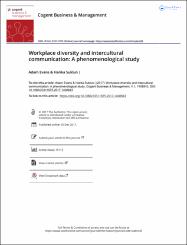| dc.contributor.author | Evans, Adam | |
| dc.contributor.author | Suklun, Harika | |
| dc.date.accessioned | 2021-07-28T08:19:42Z | |
| dc.date.available | 2021-07-28T08:19:42Z | |
| dc.date.issued | 2017 | en_US |
| dc.identifier.issn | 2331-1975 | |
| dc.identifier.uri | https://doi.org/10.1080/23311975.2017.1408943 | |
| dc.identifier.uri | https://hdl.handle.net/20.500.12573/878 | |
| dc.description.abstract | For decades, the United States has seen an increasing number of immigrants, which has led to a significant increase in cultural diversity in the United States. This phenomenological study examines the contextual history of professional non-native English-speaking women in the United States to form a basis of comparison with native English speakers. It attempts to compare their lived communicative experiences with those of non-native English speakers in the workplace. In this study, 16 professional, native English-speaking women currently working in the US were interviewed. Participants in this study were asked to describe professional and intercultural experiences through interactions with non-native English-speaking coworkers, any expectations of the interactions or violations of those expectations, and any miscommunications that may have occurred. Many native English speakers positively reflected upon these intercultural interactions and shared examples of their vocal adjustments and challenges of verbal and intercultural communication. To overcome these challenges, professional native English speakers described trying to slow speech or asking confirming questions such as Do you understand? to mitigate verbal conflicts and miscommunication. Based on the trends within the responses, however, there is a potential for unintentional and often offensive consequences to occur. Several coping mechanisms were found to be considered rude or off-putting by non-native speakers, while the intent of a more direct message was often misinterpreted by native English speakers. In addition, it seems that native English speakers often may have good intentions in their actions but do not have the skillset to better facilitate communication with non-native English speakers. | en_US |
| dc.language.iso | eng | en_US |
| dc.publisher | TAYLOR & FRANCIS ASKARL JOHANS GATE 5, NO-0154 OSLO, NORWAY | en_US |
| dc.relation.isversionof | 10.1080/23311975.2017.1408943 | en_US |
| dc.rights | info:eu-repo/semantics/openAccess | en_US |
| dc.subject | non-verbal communication | en_US |
| dc.subject | workplace communication | en_US |
| dc.subject | multicultural | en_US |
| dc.subject | communication | en_US |
| dc.title | Workplace diversity and intercultural communication: A phenomenological study | en_US |
| dc.type | article | en_US |
| dc.contributor.department | AGÜ, Yönetim Bilimleri Fakültesi, İşletme Bölümü | en_US |
| dc.contributor.authorID | 0000-0003-1016-268X | en_US |
| dc.identifier.volume | Volume 4 Issue 1 | en_US |
| dc.relation.journal | COGENT BUSINESS & MANAGEMENT | en_US |
| dc.relation.publicationcategory | Makale - Uluslararası - Editör Denetimli Dergi | en_US |


















